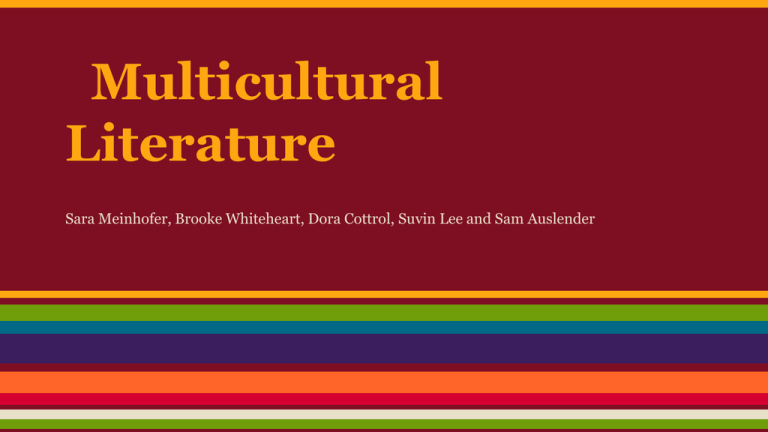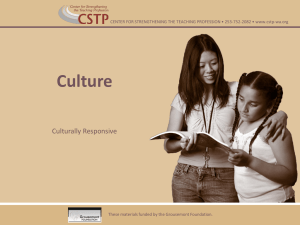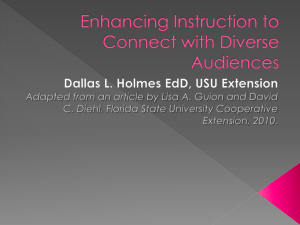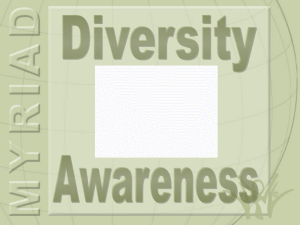Multicultural Literature
advertisement

Multicultural Literature Sara Meinhofer, Brooke Whiteheart, Dora Cottrol, Suvin Lee and Sam Auslender Multicultural/Culturally Diverse Literature • • Literary genre meant to represent the culture, patterns and traits of a variety of populations. It can include national or ethnic origin, language, religion, and geographic region. Intended to broaden a reader’s perceptions and overcome stereotypes of any particular culture. • General Characteristics of this genre include: o Multidimensional characters rooted in their culture o Authentic language in the context of the social environment o Authentic culture that reflects its values and beliefs o Factual details of culture that are naturally injected in the story through a modern perspective o Helps children value their own cultural heritage and the heritage of others Subcategories and Characteristics • • Culturally Neutral Books: have a diversity of characters from different cultures, but contain no culturally specific information. Intended to expose the readers to diversity. It also helps minority children identify with characters in these books. Culturally Generic Books: have characters specific to a cultural group, but have little culturally specific information. The lives of these characters are depicted within the larger American culture and plots are consistent with the dominant American society. Culturally Specific Books: contain details that indicate the characters as members of a specific cultural group. These books often mix specific characteristics of a minority cultural group with elements of the larger American cultural group. Specifics in these books often include religion, names, values, attitudes and interactions inside and outside the cultural group. Serious themes such as past and present racial oppression in the United States and abroad are addressed in culturally specific books. Additionally, themes involving the importance of cultural heritage are addressed in these books. In Bikole: Eight Modern Stories of Life in a West African Village, by Tom Gilroy, illustrated by Mica Vachula This is a compilation of short stories of real events of villagers of Bikole, a small West African village. Some are sad, but all are extremely interesting and memorable. Published in 1978, it is a bit dated, but the stories are timeless. All of the stories have some sort of African culture woven into them. One story was about a determined husband taking an expecting wife through a sandstorm ten miles away to the nearest hospital. Many women in the village did not go to the hospital for births, but they were determined. One story was about a wrestling match, which brings a lot of attention throughout the village and nearby villages. The most memorable story was about a woman sold into marriage, but defied her father and ran away and was never seen or heard from again. This book I would say is appropriate for about a fifth or sixth grade classroom. They provide good examples of modern culture mixing with old customs. It was written by Tom Gilroy, who lived in Bikole for two years, working for the Peace Corps. This book is a good example of a book that explores cultural aspects of everyday life. Over Here It’s Different: Carolina’s Story, by Mildred Leinweber Dawson, photographs by George Ancona This book describes one person’s story through the process of immigrating to the Queens, New York, from the Dominican Republic. This process took several years. I did not realize how long of an ordeal this was. Some of the things described are the differences in food, the language barrier, and other topical issues. An interesting quote from the book that I found was “The Dominican Republic now sends more immigrants to the United States than does any other Caribbean nation”. This book was not my favorite, and would be best used in a classroom setting by taking excerpts. It has good information, but is not the most exciting book I’ve ever read. This is a good book used to describe a specific first hand account of immigration. It shows the blending of Dominican culture with the culture of Queens, New York. How My Parents Learned to Eat Author: Ina R. Frideman Illustrator: Allen Say Publication Date: April 28, 1987 An American sailor courts a young Japanese woman and each tries, in secret, to learn the other's way of eating. The story is told by their their daughter, who is explaining why they eat two different ways in her household. This book portrays the subtle similarities and differences among Japanese and American culture. This book would best be used for ages 7-9 years old. Inside Out & Back Again Author: Thanhha Lai Publication date: February 22, 2011 This book is a Newbery Honor book and winner of the National Book Award. Told through poetry, it is a story of a ten year old girl named Ha and her family fleeing Vietnam and immigrating to Alabama during the Vietnam War. She is thrust into this new foreign culture and has to deal with the language barrier, unkind strangers and “dullness” of its food. This book demonstrates the vast differences between Vietnamese and American culture and would be a great read for students ages ten through twelve. This story is based off of the real life experiences of the author Thanhha Lai. Esperanza Rising Author: Pam Munoz Ryan Published in 2000 Summary: Esperanza Ortega is a wealthy young girl along with a very loving family. One day, her father and some of his men are killed by bandits while they are in their ranch during the Mexican Revolution. Her father left everything for his wife and Esperanza until the lawyer says most of the things in the ranch belongs to Senor Ortega’s brother, Luis Ortega. As the story goes on, Luis proposes to Esperanza’s mother, Ramona, and she later on accepts the proposal. However, Ramona tells Esperanza she is not truly planning on marrying Luis, but to get everything the dad owned and escape to America. They succeed in tricking Luis and escape to America. Although they are successful in escaping to America, the Great Depression occurs, and Esperanza faces another downfall... The Colors of the Rainbow Author: Jennifer Moore Mallinos, Marta Fabrega Published in 2005 Summary: This book is for children (focusing on preschoolers) to understand the concept of different ethnicities. The authors create a very interesting theme. When different races and ethnicities come together, they form a beautiful sight, like a rainbow. The authors also point out people are all different, but they share similar feelings, thoughts, hopes, dreams, and so on. The main purpose the authors tried to focus on was for children to come together as a one, and it will create something beautiful like the rainbow! The two authors also wanted to focus on preschoolers and encourage them to express their feelings, and then to speak openly about it. The authors believe children have to overcome problems and achieve emotional stability. Tea With Milk Author: Allen Say Illustrator: Houghton Mifflin Harcourt Published: 1999 Synopsis: Tea With Milk tells the story of May (Masaka) and her transition from moving from San Francisco to her parent’s native Japan. The story begins in San Francisco with May noticing the differences between her family and their traditions and the traditions of that of American families. Besides language, one main difference she notes is in the food and drink (ie. Americans families drinking Tea with Milk & Sugar and her Japanese family drinking plain tea). After high school, May and her family move to Japan. Masaki's parents want her to fully learn and embrace Japanese culture, so they send her back to high school to learn more Japanese. There she is teased and taunted for being a gaijin (foreigner). Masaka has ambitions of gaining her independence, getting a job and going to University like other Americans her age. In doing so, she finds a job in a nearby city where she finds her 1st language of english to be of benefit. This story relates well to the genre because it reflects many of its required elements of culturally specific books such as authentic cultural details and helping of the reader value their own heritage and the heritages of others. Many students can relate to the story, especially if they are 1st generation, recent immigrants or have friends who are immigrants. Henry’s Freedom Box: A True Story of the Underground Railroad Author: Ellen Levine Illustrator: Kadir Nelson Published: 2007 -2008 Caldecott Winner Depicts the true story of a slave named Henry Brown who works in his master’s factory sorting tobacco and who longs for freedom. Henry get married to a slave of a different master named Nancy and has three children. Nancy’s master comes into financial hardship and sells Nancy and their 3 children, leaving Henry all alone. Still longing for freedom, Henry makes arrangements with an abolitionist named Dr. Smith to mail himself to Philadelphia, Pennsylvania in a wooden box. Henry spends many days in this wooden box being shipped to the North, fearing for his life and loss of freedom the entire way. When he arrives to Philadelphia he meets his friends and is nicknamed Henry ‘Box’ Brown. This book fits in well with multicultural literature because it portrays historically accurate, culturally specific information that addresses racial tensions and Slavery. This story is great for children to connect and learn more about Slavery and Henry Brown. This is an especially great book to read to Virginia students as it takes place in Virginia. The Snowy Day AUTHOR/ILLUSTRATOR: Ezra Jack Keats PUBLISHED: 1962 -1963 Caldecott Winner The Snowy Day features a named Peter that explores his neighborhood after the first snowfall of the season. Keats was harshly criticized in the early 1960’s due to his lack of specifying Peter’s race throughout the entire book. This was during the Civil Rights era where it was considered “unacceptable” to have a main character that was of a different race other than white. The Snowy Day applies to multiculturalism literature because it was written for all children, no matter what race they might be. Keats noted that he wanted to “capture the wonderment of a child’s reaction to the first snowfall”, regardless of race or religion. Squanto, Friend of the Pilgrims AUTHOR: Clyde Robert Bulla ILLUSTRATOR: Peter Burchard PUBLISHED: January 28th, 1954 Squanto, Friend of the Pilgrims is a historical non-fiction story about the adventures of Squanto, the Native American who helped the English settlers travel across the Atlantic Ocean. Although his family advises him not to go, Squanto does anyway and assures them that he will return. In time, he does return, however, his village is empty and his family is not in sight. This book is appropriate not only for historical non-fiction, but also multicultural literature. Students will learn about the culture of native americans as well as the history of the events leading up to the Mayflower voyage. Tell Us About Your Culture! • • • Create a flag or symbol of significance of a culture which you identify with On the back, write about why you identify with that culture What ways do you identify with it? What makes it special to you? What are some of your traditions? When finished, share with your group :)







